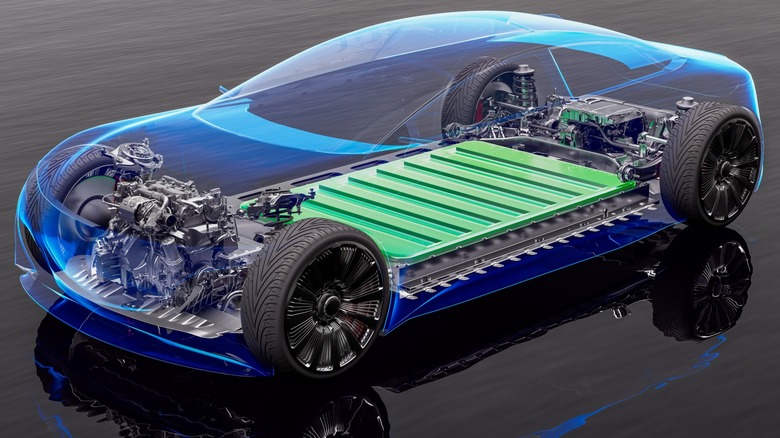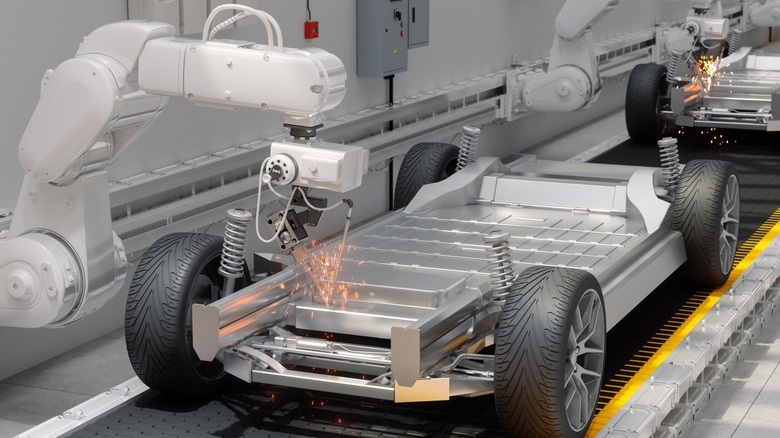Will Charging An Electric Car Ever Be As Quick As Getting Gas?
Electric cars might seem like a new thing, but they've actually been around for over a century. Back in 1890, an Iowa chemist came up with an early electric vehicle that could up to 14 miles per hour. While it was a cool idea at the time, those early versions just couldn't keep up with the convenience, performance, and price of gas-powered cars, so they eventually disappeared from the spotlight.
Fast forward to today, and electric cars are back — better, smarter, and cooler. Carmakers have been able to iterate and transform the electric vehicle into something far more practical. They're quieter, easier to maintain, and often advertised as a more sustainable alternative to traditional internal combustion engine cars. Yet despite their modern appeal and clear benefits, EV adoption in the U.S. remains surprisingly low: In 2023, just 10% of new cars sold were electric, compared to an impressive 93% in Norway.
So, what's stopping Americans from making the switch to electric cars? For many people, it's the long amount of time it takes to charge an EV. A lot of drivers still can't fathom why they should shell out thousands of dollars only to go from filling a gas tank in under five minutes to waiting hours for a full charge. And then there's the issue of range anxiety: A full tank on an ICE car can take you a predictable number of miles every time, but an EV's range can fluctuate, especially in extreme weather.
However, what if charging an EV could be as fast as getting gas? Could this be the breakthrough that encourages more people to consider making the switch? And more importantly, is our current infrastructure even capable of supporting such a shift in demand?
How long does EV charging take compared to pumping gas?
For most drivers with internal combustion engine cars, all you need to do is make a quick stop at the gas station. In less than 10 minutes, your tank is full, and you're ready to get back on the road. However, for EV owners, the experience is very different. First of all, charging an EV isn't as quick or straightforward as pumping gas. That's one of the biggest problems facing electric cars.
Unlike a gas pump, public EV chargers rely heavily on software to discharge electricity, manage the different types of EVs and their batteries, and process payments. This level of technology ought to be convenient, but what it really means is there are more opportunities for hiccups — like a malfunctioning charger or a software glitch that leaves you waiting longer than expected.
And that can be pretty inconvenient, considering how much longer it already takes to charge. Not all EVs are the same, so charging speeds vary between models, but the time it takes also depends on where you're charging and the equipment you're using. Most EV owners opt for a Level 2 charger at home — which, while faster than the basic Level 1, can still take several hours for a full charge. On the flip side, Level 3 chargers — which you'll often find in high-speed public networks — can get your battery to 80% in about 30 minutes.
However, fast charging comes with its own trade-offs. You can't use it every day without damaging your EV's long-term battery health. So, it is really only ideal for long trips or when you're pressed for time. Additionally, extreme changes in temperature can also affect how your battery responds, slowing the process down even further.
Why can't EVs charge faster right now?
Three main factors influence the rate at which an electric vehicle charges: the chemical makeup of the EV's battery, its size, and the weather. Today's EVs are powered by lithium-ion batteries. While they represent a major leap in technology from internal combustion engines, they are far more sensitive when it comes to how they charge, cool, and regenerate energy.
When you plug in your electric vehicle to charge, this is how the battery works: Lithium ions move through a liquid electrolyte from the cathode to the anode. The speed of this movement directly impacts how fast the battery charges. However, if the ions move too fast, it can cause the battery to overheat, degrade quickly, or, in severe cases, lead to lithium plating.
Lithium plating is particularly dangerous, and it happens when lithium builds up on the anode's surface instead of fully entering it, increasing the risk of short circuits and can lead to fires. If you've ever wondered why some electric vehicles catch fire, that's typically how. To prevent this, EV batteries come with proprietary battery management systems that monitor charging speeds and regulate how much power the battery can safely take in. Even if you plug into a super fast charger that delivers a charge at a rate of 350 kW, if your car's battery is designed to accept 50 kW maximum, it won't charge any faster. Similarly, larger batteries will naturally take longer to charge simply due to their size.
Weather also plays an important role here. In cold temperatures, lithium-ion batteries are less efficient because the liquid electrolyte thickens, slowing down the movement of the ions. As a result, charging takes even longer during winter, regenerative braking may be suspended, and your vehicle's range reduces more rapidly, translating into longer charging times.
What if EVs use different batteries?
Many experts believe that changing the current battery chemistry could help speed up the movement of lithium ions and eventually reduce how much time an EV takes to charge. One promising option is replacing the liquid electrolyte in traditional lithium-ion batteries with a solid material to make solid-state batteries. This change offers two big advantages: It makes the batteries safer, and less likely to overheat.
Since the liquid electrolytes in today's batteries are flammable, solid-state designs are a relatively safer alternative. This technology also opens up the opportunity to use different anode materials that are better at resisting lithium plating. For example, solid-state batteries could potentially use lithium metal, which is capable of storing more energy. In theory, this means EVs could charge faster and hold more power.
Solid-state batteries aren't perfect, though. While they're safer and more efficient, dendrites can form, leading to short circuits. However, researchers believe that using a different composite of materials makes it possible to prevent the buildup of lithium dendrites. Experts predict that with continued research, ultra-fast charging batteries could hit the market in the next five years.
An announcement in 2023 from a leading Chinese battery company, CATL, makes this even more promising. The company revealed it had successfully developed a fast-charging battery that can add up to about 250 miles of range in 10 minutes. For context, Tesla's current fast charging adds up to roughly 200 miles of range in 15 minutes.
As exciting as this sounds, one can only wonder how this will affect the affordability of electric cars. EV car batteries are already so expensive to build, and these new advancements could drive prices even higher. If these super-fast batteries make EVs even more expensive, it'll only further put them out of reach of many Americans.
How sustainable is it really?
Right now, most EV owners charge their cars using 120 or 240-volt outlets at home, and this already draws a tremendous amount of power from the grid. While many people can install a home charger in their garage, people also live in apartment buildings or multi-unit housing and have to rely on public chargers. As battery technology advances, the infrastructure also needs to catch up. There's an added challenge of expanding fast-charging networks to match the capacity that these new batteries can handle.
However, scaling up any further on the batteries and, ultimately, the chargers will only put extra pressure on the electric grid. As more people transition to EVs, the big question becomes: Can our power grid handle the surge in demand? It's Electric, a U.S. startup, is looking to solve this problem by installing curbside chargers that draw power from buildings rather than connecting to the grid. In the meantime, hybrid cars may offer a comfortable middle ground, as they already serve as the perfect choice for drivers who want to reduce their carbon footprint, but aren't quite ready to go full-on electric.
Looking further into the future, some experts are proposing electrified roads where cars charge as they drive. In fact, plans are underway to build the first electrified road in the U.S. in Detroit, Michigan. At the end of the day, it's important that we don't lose sight of what really matters. EVs are fundamentally different from internal combustion engine cars, and perhaps instead of trying to make them more alike, the focus should be on improving access to reliable public charging. Ensuring that EV range is more stable and consistent would give drivers who need the extra miles a feeling of confidence that their electric cars will meet their needs.




